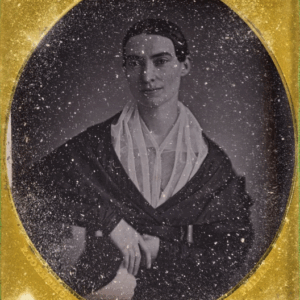JTF (just the facts): A total of 19 black and white photographs, alternately framed in white and blond wood, and hung against white walls in the single room gallery space in the back. All of the works are gelatin silver prints, made between 1994 and 2013. Each of the prints is sized 11×14 or reverse and is available in an open edition. (Installation and detail shots below.)
Comments/Context: David Battel’s street photographs are conscious throwbacks, pictures that feel strongly reminiscent of a silvered past, but were taken in the past decade or so. Stripped of obvious identifiers of time and place, they seem to float in an indeterminate space, resolutely analog in a digital age and plainly respectful of the stylistic traditions of the genre, but then incongruously contemporary. He’s using an eye of the past to see the present, creating a combination of timeless homage and active reengagement.
It’s a strange feeling to wander through a show and constantly be thinking that the work looks like that of a more famous master photographer – I found myself rattling off a string of names as precedents, as though these modern pictures had actually been made decades earlier. The delicate shadows and sensitive textures of a crumpled hat and a turned back are a dead ringer for depression era Lange, while a woman covered by a large scarf with a suitcase in the background looks like a found immigrant Madonna from Hine. A bellhop receding into dots of lights, a girl in polka dot dress, a priest on the street, a man with an eye patch, a subway embrace, a pair of Port Authority refugees, and a pensive older man in a church pew alternately took me to Evans, Frank, and early Strand, with just the right balance of blur and crispness, dejection and romance.
Garry Winogrand is perhaps the most obvious influence here, particularly in the way figures are framed on the sidewalk. Battel’s women offer many of the same attitudes and energy as Winogrand’s did – the echoes of skin in a baby being carried by a Coney Island mother in a shiny dress, the elegant turn of a long limbed shoulder in Times Square, the confident stride of a smoking woman, or the interactions of pairs with heads leaned in. Other images capture Winograndian gestures and classic Americana, from a man fixing his son’s tie in the crowd of the street to the elongated form of a white convertible amid the traffic.
I must admit that I was ready to dismiss these images as faint echoes of better pictures made earlier. But there is a consistency to Battel’s vision and craftsmanship that is undeniably convincing – these photographs are repeatedly well seen and smartly composed, even if they overtly tug on strings to other photographic memories. He’s not just turned on the sepia filter to give us a dose of nostalgia. Instead, he’s steeped himself in the lessons of the past, channeled his favorites, and made his own pictures that deftly celebrate a certain type of now-vanished photography.
Collector’s POV: The prints in this show are priced at $1050 each. Battel’s work has little secondary market history, so gallery retail remains the best option for those collectors interested in following up.











